|
FAQs on Identification of Stinging-Celled
Animals 16
Related Articles: Cnidarians, Water
Flow, How Much is Enough,
Related FAQs: Cnidarian IDs 1, Cnidarian IDs 2, Cnidarian IDs 3,
Cnidarians ID
4, Cnidarians ID
5, Cnidarians ID 6, Cnidarian ID 7, Cnidarian ID 8, Cnidarian ID 9, Cnidarian ID 10,
Cnidarian ID
11, Cnidarian ID 12,
Cnidarian ID 13, Cnidarian ID 14, Cnidarian ID 15, Cnidarian ID 17, Cnidarian ID 18, Cnidarian ID 19, Cnidarian ID 20, Cnidarian ID 21, Cnidarian ID 22, Cnidarian ID 23, Cnidarian ID 24, Cnidarian ID 26, Cnidarian ID 27, Cnidarian ID 28,
Cnidarian ID 28,
Cnidarian
ID 29,
Cnidarian ID 30,
Cnidarian ID 31,
& Anemone ID 1,
Aiptasia ID 1, Stony Coral
ID 1, Mushroom Identification,
Soft Coral ID, Alcyoniid ID, Xeniid ID,
|
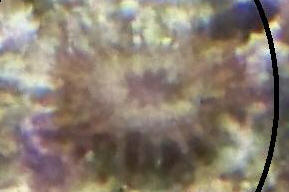
|
|
Melting Platygyra and identification 02/09/09
Hi Boys and Girls, I love the info you make available on this
site, however I have difficulty finding answers even when
searches show results, I read through both linked archives
entirely twice, learned all kinds of stuff but not the thing I
wanted to learn. That being said I hope you don't mind
answering this question yet again. <Thank you and of course
not> I have a ~290g (tank+sump) that has been running for
about a year and a half. 50 L x 32 H x 32 D. As I only add a
little at a time we have about 210 lbs of live rock on the right
side of the tank. We have one 450W MH over that side and 4
actinics that run the length of the tank . Will eventually add
another 450 at other end before it becomes populated with corals
and such. We have heaters and Tunze skimmer in sump. Top up daily
and add Tropic Marine bio-calcium. We feed New Life Spectrum
Pellets early day and alternate nightly with frozen Spirulina
enhanced Brine Shrimp and Mysis Shrimp, 2 - 3 times a week we add
an ounce of DT's Phytoplankton and alternate days Cyclopeeze.
All chemical tests are in good to excellent range, Nitrite,
Nitrate and Ammonia are 0, etc. Inhabitants include 5 blue
damselfish (blue devils) 1 male, 4 females 1 six line wrasse 1
blue green chromis and 1 clownfish (false) 1 sea hare, rather
large 6-7 inches long (wasn't when we got it, 2.5 inch) 5
shrimp, 1 blood, 3 cleaner and 1 peppermint 25+ each, hermit
crabs and snails Ricordea, Rhodactis and Discosoma mushrooms, in
blue, green, green stripe and spoted, red, and orange Frogspawn
Elegance Lg BTA that has split and now has smaller sibling 2
Clams 1 LG (volleyball size when fully open, about 11 in) and 1
smaller (4 in) 2 Fungia (1 Orange, 1 Green) 1 Blastomussa 1
Symphyllia 1 Platygyra 1 Green Star Polyp (weed in my setup
slowly trading for other things) 5+ pieces candy coral Anyhow, we
had a large infestation of flatworms, and thought to syphon out
as many as possible. Dummy, (that would be me) didn't think
and syphoned through a screen putting water back into tank.
<yikes!> It never occurred to me that I was going to poison
my tank ( I now know better). <good> I lost all 3 Tangs,
yellow, blue and purple along with the flatworms. <?!> At
this point everything else was not looking so good so we moved as
much as possible to a 30g that was running upstairs while waiting
for toxin to clear up with carbon. Figured we had nothing to
loose and decided to go ahead with a treatment of Flatworm Exit
from Salifert. Seems to have worked great, my sand is white
again. Ran carbon for 5 days before moving everything back.
Everything seems to have recovered, but my Lg. Anemone decided to
shift about 6 inches from where it has been for the last 10
months, bringing it too close to the Platygyra. I moved it up and
over about 8 inches. Now it appears to be melting. Is it possibly
damaged or hurt from Anemone? <It is dropping polyps (a form
of asexual reproduction). This is not necessarily a bad thing.
It's actually pretty cool.> Or does this coral propagate
in this way. <one way, yes, bingo> Please see attached
photo. Also at the same time could you possibly identify a few
things from these 2 photos as well. The polyp just under the
Platygyra is a pest <I can't see much in the photo (thank
you for labeling them though), but they look like hydroids.>
that has been showing up all over my tank but I don't know
what it is and the other coral above it in the photo I forgot to
write down and the LFS doesn't remember that particular
purchase and can't tell me. <I do think they're pest
hydroids (my guess):
http://www.wetwebmedia.com/hyzoanidfaq.htm> In the other photo
there are 2 mystery coral, one encrusting and one that is
actually the live rock skeleton that survived and another pest
that I have been trying to eradicate to no avail. <The one
encrusting looks like it might be Montipora, but I really
can't tell from the photo. I'm sorry, but the other one
is also just too difficult to make out. Do you think you could
take and send better pics?> Keeps coming back all over the
tank, grows like a plant. The last photo is just entire right
side just for visualization. Thanks so much for your help in
advance. Christine <De nada, Sara M.>
|
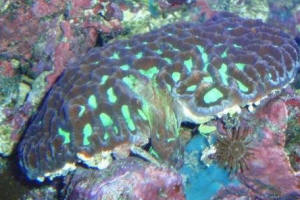 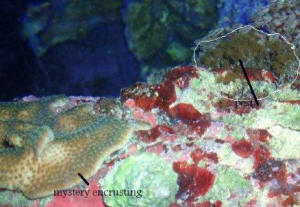 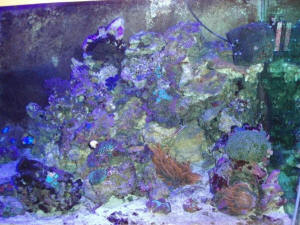 |
|
I.D. Please; Featherduster 1/29/09
Hi guys,
<Hello>
I appreciate your service very much as it has been very useful. I
am very green when it comes to saltwater aquatics. I have sent a
pic to hope that someone my identify this little creature. They
are white, round and feathery like.
<Looks like a small feather duster, a harmless filter
feeder.>
I have 3 little ones as pictured they are about the size of a BB
and I have a larger one about the size of a quarter. I would have
loved to get a picture of the larger one, but, it's in a
crevasse and not able to get any pictures. My tank is a 55g and
is about 6 months old. Thank-you.
<Please compare them to http://www.wetwebmedia.com/feather.htm
and the linked FAQs on ID. Also, compare them and the larger ones
to
http://www.wetwebmedia.com/marine/inverts/cnidaria/anthozoa/aiptasia/aiptasia.htm
and the linked FAQs on ID. Sometimes they are apparently thought
to be the same. I do wish you much fun with your hobby. Cheers,
Marco.>
|
 Mmm, looks like an Octocoral/"Polyp" to RMF. Mmm, looks like an Octocoral/"Polyp" to RMF.
Re: I.D. Please --
1/30/09
"Mmm, looks like an Octocoral/"Polyp" to
RMF."
<Yes, I also saw that there are 8 tentacles, but solitary
Octocorals are quite uncommon, limited to 3 or so genera from
deep waters like Taiaroa sp.
There are small feather dusters like Brachiomma curta that have
relatively few arms (about 12), Spirorbis sp. has 9. What do you
think? ...a better picture would reveal more detail.
Marco.>
<Mmm, do agree with you all the way around... but thought
I'd toss in my dos centavos re the Cnid. poss. Danke,
BobF>
|
|
What is it question 01/22/09 I have posted
this on a couple of forums and have gotten various responses. My
tank is about 6 months old. I have added rock, sand and frags
from several different tanks and locations. They showed up one
time and thinking they were aiptasia I used pickling lime on
them. <Not aiptasia> They have shown up again and in two
different locations so I thought I should ask what they are.
<I believe they are hydroids.> They are pretty small, about
1/16 in diameter to give you a scale. Two pics: one is under 20k
MH with 460n actinic (darker one) the other is with same lighting
with flash bounced in from the top. What is it? <I'm 95%
sure they are some type of hydroid (the brown proteinaceous tubes
give them away).> Thanks, Steven
<De nada,
Sara M.>
|
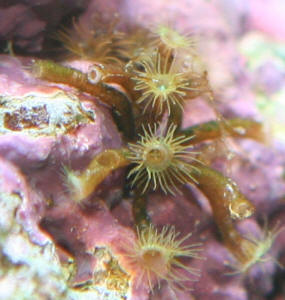 Well done. RMF Well done. RMF |
| <I agree with Sara, these are likely colonial
Hydroids, probably family Tubulariidae, possibly even of genus
Tubularia or related. Should not touch sensitive corals, may become
a pest or simply vanish someday within a short time. Nice pictures
with great detail. Thanks for sending. Marco.> |
|
Coral/Polyp identification--
1/20/09 Greetings, <Hello Jack, Minh at your
service.> I will repeat what most other writers say; you have
a great web site. I would be hard pressed to total how many hours
I have spent reading the information you offer. <We're
here to help.> Four months ago I made the switch from fresh to
what was intended to be a FOWLR marine by setting up a 38 gallon.
I selected lighting ( a T5 HO fixture with one 39 Watt 10K and
one 39 watt 460nm Actinic Blue) with no expectation of keeping
anything other than fish. Some live rock hitchhikers have me
rethinking that. <Excellent lighting choice. Most T5 HO set
ups are very capable.> The organisms in the attached photos
seem to be doing well under my lighting and conditions. I am
specifically looking for identifications for future care, and
suggestions of other species that may do equally well under
similar lighting conditions. Photo 1 upper half as well as a side
shot at the lower right corner. <The upper half in this photo
shows a Zoanthid colony. More information including care advice
can be found here: http://www.wetwebmedia.com/zoanthid.htm.>
Photo 2 is a direct shot of the item in the lower right of #1.
<This coral appears to be one from the Faviidae family, genus
Caulastrea. More information including care advice can be found
here: http://www.wetwebmedia.com/faviidae.htm.> Photo 3 upper
is the same as in #1 upper, and two other items in the lower
lower left. There are others identical to these last two
elsewhere, and they have grown about 4-5x larger in 4 months.
<These are pest anemones, Anemonia Majano. For more
information including removal methods, please review:
http://www.wetwebmedia.com/anemoniafaqs.htm> All of these are
between 8-12 inches from the lighting. I have 2 Clowns, a Yellow
Goby, a very small Bi-color Angel, and assorted crabs and snails.
40lbs sand, 30lbs live rock, HOT filter with Polyfilter and
Chemipure and Remora skimmer. PH 8.2, Ammonia 0, Nitrite 0,
Nitrate barely measuring. <It appears that your basic water
parameters are within proper range. As you venture further into a
full blown reef tank, more attention should be paid to some other
water parameters such as phosphate, calcium, alkalinity and
magnesium. For more information on these elements, please review
this excellent multi-part guide: "The 'How To' Guide
to Reef Aquarium Chemistry for Beginners"
(http://www.reefkeeping.com/issues/2007-03/rhf/index).
Furthermore, I suspect other soft corals
(http://www.wetwebmedia.com/soft.htm) such as corals from the
family Alcyoniidae (http://www.wetwebmedia.com/alcyoniids.htm)
and Xeniidae (http://www.wetwebmedia.com/xeniidarts.htm) would do
well in your tank's current lighting scheme.> Thanks you
any information or suggestions. <You're welcome. Cheers,
Minh Huynh.>
|
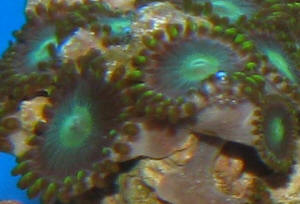
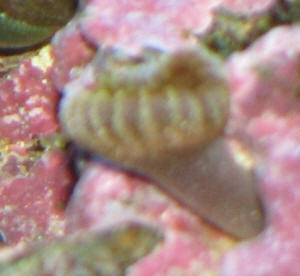 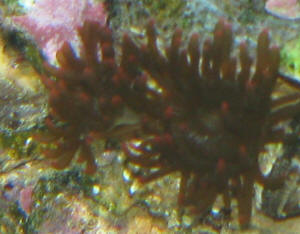 |
|
Identification if possible... Majano
or Palythoa 1/16/2009
Hello,
<Hi there, Mich here.>
I have read a lot of information on your site over the past
couple months and it has been a big help.
<Glad to hear!>
Now I have a question that I cannot seem to find the answer to. I
have posted on two different forums and the replies I got were
mixed. Basically guesses, and I have searched the web and looked
at tons of photos with no luck. The closest I got was a picture
that looked similar to it but they didn't know what it was
either no help there. I'll be enclosing 2 photos there the
same photo only one is closer. They are unfortunately blurry but
the best I could get at this time.
<I see, not the clearest, but....>
This item I'm wondering about came home with me when I bought
a piece of live rock from a LFS *the only store I use for the
live critters* they only sell saltwater items. It was a small
rock but had a brittle star, about 30 zoas of 3 different colors,
some feather dusters and other hitchhikers on this tiny rock.
<Sweet!>
Well the issue is the one lone living thing it has doubled in
size since i got it 2 months ago,
<Fast grower.>
It is brownish darker in the center. Reminds me of a Zoa but
instead of one row of tentacles from it it has two distinct
rows.
<Ahhh, the photo almost looks like a Palythoa, but the double
row of tentacles makes me think it is a majano, as you can see in
this image here:
http://images.google.com/imgres?imgurl=http://www.esanaquatics.com/Majano_An
emone.jpg&imgrefurl=http://www.esanaquatics.com/Majano%2520Anemone.htm&usg=_
_KJ0A3D9LRtmfucyiJgJtZFbPYN0=&h=600&w=800&sz=114&hl=en&start=4&um=1&tbnid=b3
PGLWR5F-vbzM:&tbnh=107&tbnw=143&prev=/images%3Fq%3Dmajano%26um%3D1%26hl%3Den
%26safe%3Doff%26client%3Dsafari%26rls%3Den-us%26sa%3DN
I just recently had aptasia show up *only 2 right now*
<Good.>
I will be dealing with them this weekend when i can pick up some
stuff to rid myself of it.
<Boiling hot water, lemon juice, Kalk, also work well.>
*I'd like to use a live means such as a shrimp over
chemicals, opinion?*
<See above. A note on peppermint shrimp, they work well if
they are hungry, but I think Aiptasia are the human equivalent to
white rice, though some people like rice, it's just not most
people's first choice if they could have a something
else.>
Anyways this thing hasn't bothered anything I have other zoas
and some star polyps along with a BTA and two clowns.
<I do think it is a Majano and would remove it.>
My systems tests have come up normal everything looks good, all
is healthy in the tank. It is however a 26g
<Too small for two clowns in my opinion.>
I will be upgrading in a couple months but don't wanna do
that till I at least attempt to correct the problems now.
<Will need more room soon.>
Okay here are the pictures ... it isn't touching the zoas its
tentacles are not bulbous just straight like the zoas. Im hoping
its just a neat type of Zoa or at least something that isn't
bad.
<Could be a Palythoa, but I'm still leaning towards the
Majano.>
My system is only 6 months old but i have a bunch of copepods and
amphipods and other critters on the glass and the Stomatella
snails have been multiplying
<All good.>
*many babies on the glass* any idea what this is would be very
helpful or at least a place to look at pictures of what u think
it is. I have looked at pictures of majano anemones it is not
that from the pictures I've seen anyways.
<If it's not a majano, then I think it is a palythoa, but
I do wish the picture was just a little clearer.>
thank you so much for your help
<I hope this helps.
Cheers,
Mich>
|
 |
|
|

